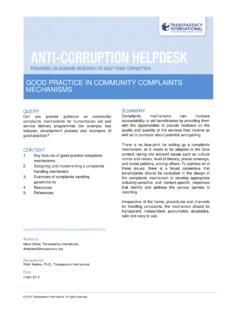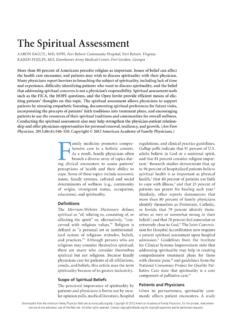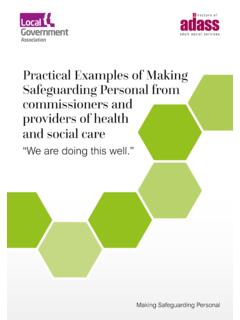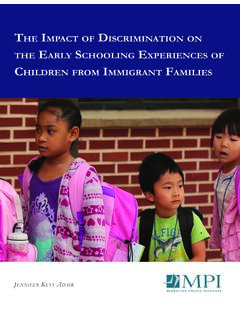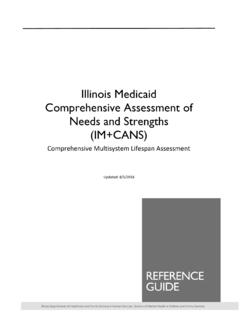Transcription of Women’s Mental Health - World Health Organization
1 Women s Mental Health : An Evidence Based Review World Health Organization GenevaWHO/MSD/ OnlyDistr.: General1 WOMEN S Mental Health AN EVIDENCE BASED REVIEWM ental Health Determinants and PopulationsDepartment of Mental Health and Substance DependenceWorld Health OrganizationGeneva20002 AcknowledgementsMeena Cabral, Department of Mental Health and Substance Dependence, WorldHealth Organization and Jill Astbury, Associate Professor and Deputy Director of theKey Centre for Women's Health in Society, University of Melbourne, Australia, wishto thank warmly the reviewers who provided insightful comments for theimprovement of this document. They include: Dr Assia Brandrup-Lukanow, RegionalAdviser, Women and Reproductive Health , WHO; Dr Herbert Friedman, Consultant,London, UK; Dr Claudia Garcia-Moreno, Evidence and Information for Policy,WHO; Dr Michelle Funk, Department of Mental Health and Substance Dependence,WHO; Ms Talat Jafri, UNIFEM, New York, USA; Ms Pirkko Lahti, The FinnishAssociation for Mental Health , Helsinki, Finland; Dr Lenore Manderson, Universityof Melbourne, Australia; Ms Naana Otoo-Oyortey, International Planned ParenthoodFederation; Dr Judith A.
2 Oulton, International Council of Nurses, Geneva,Switzerland; Dr Sundari Ravindran, Consultant in Women's Health , New Delhi,India; and Women's Health Bureau and Mental Health Promotion Unit, HealthCanada, Ottawa, copies of this document may be obtained from: Mental Health Determinants and PopulationsDepartment of Mental Health and Substance DependenceWorld Health Organization1211 Geneva 27 Switzerland World Health Organization , 2000 This document is not a formal publication of the World Health Organization (WHO), and all rights arereserved by the Organization . The document may, however, be freely reviewed, abstracted, reproducedor translated, in part or in whole, but not for sale or for use in conjunction with commercial views expressed in documents by named authors are solely the responsibility of those WOMEN S Mental Health : AN EVIDENCE BASED REVIEW Table of ContentsAcknowledgements_____2 Table of contents_____3 Preface_____5 Introduction_____7 PART ONE : GENDER DEVELOPMENT AND HEALTH_____11 Background_____11 Social position, poverty and health_____14 Influences on women's well being.
3 Gender development_____15 Economic policies, access and equity_____18 Economic policies and women's social position_____20 Social position, righs and Mental Health promotion_____25 Women's Mental Health concerns_____28 PART TWO : DEPRESSION IN WOMEN_____31 Social theories of depression_____31 Social theories of depression in women_____34 Characteristic features of severe events: humiliation and entrapment__36 Social mentalities and rank_____39 Severe events and rates of depression_____41 Summary_____44 PART THREE : POVERTY, SOCIAL POSITION AND Mental HEALTH47 Relationship between social class and Mental health_____47 Measurement of women s socio-economic status (SES)_____49 Behavioural risk factors, physical and psychological comorbidity_____52 Need to link physical and Mental health_____53 Chronic difficulties and acute crises_____56 Summary_____57 Place, severe events and depression_____58 Core ties, identity and the ethic of care_____604 PART FOUR.
4 VIOLENCE AGAINST WOMEN_____65 The problem_____65 Terminology_____66 Violence in Health care_____68 Prevalence of violence against women in 'peace' time_____69 Physical partner violence_____70 Violence and reproductive functioning_____70 Sexual violence in adulthood_____71 Reactions to violence_____71 Child sexual abuse_____72 Multiple forms of violence_____74 Revictimisation_____74 Consequences of violence_____75 Common features of violence and depression_____76 Suicidal behaviour_____77 Depression and anxiety_____77 Post-traumatic stress_____80 Comorbidity and the burden of violence_____81 Barriers to understanding_____82 Accounting for violence_____83 Coping with violence_____84 Summary_____86 Reducing the psychological impact of violence_____86 Psychosocial factors_____89 Need for multilevel analysis_____89 BIBLIOGRAPHY_____955 PrefaceWe are pleased to present this evidence based review which contains a reappraisal ofthe status of women s Mental Health problems in different regions of the World .
5 Itupdates and reactualizes a first publication on Psychosocial and Mental HealthAspects of Women s Health issued by the Divisions of Mental and Family Health the years, the work of many WHO departments has converged with the concernsof the Key Centre for Women's Health in Society, University of Melbourne, indocumenting the impact of discrimination and low socio-economic status on thehealth of women. More recently, there has been a shift from a focus on women to afocus on gender as a critical determinant of Health . We are committed to theintegration of gender issues in all our work and to the utilization of gender analysis inthe development of Mental Health policies and programmes. In line with therecommendations articulated in the Beijing Platform of Action, the Programme ofAction of the International Conference on Population and Development, and theConvention on the Elimination of All Forms of Discrimination Against Women, weare strengthening attention to the tremendous Health burden of women that is createdby gender discrimination, poverty, social position, and various forms of violenceagainst the Global Burden of Disease, it is estimated that depression will become thesecond most important cause of disease burden in the World by the year 2020.
6 Womenin developed and developing countries alike are almost twice as likely as men toexperience depression. Another two of the leading causes of disease burden estimatedfor the year 2020, namely violence and self inflicted injuries, have special relevancefor women s Mental document adopts a Health determinants framework for examining the evidencerelated to women s poor Mental Health . From this perspective, public policy includingeconomic policy, socio- cultural and environmental factors, community and socialsupport, stressors and life events, personal behaviour and skills, and availability andaccess to Health services, are all seen to exercise a role in determining women smental Health status. Similarly, when considering the differences between women andmen, a gender approach has been used. While this does not exclude biological or sexdifferences, it considers the critical roles that social and cultural factors and unequalpower relations between men and women play in promoting or impeding mentalhealth.
7 Such inequalities create, maintain and exacerbate exposure to risk factors thatendanger women s Mental Health , and are most graphically illustrated in thesignificantly different rates of depression between men and women, poverty and itsimpact, and the phenomenal prevalence of violence against document collects and analyses the latest research evidence pertaining to thestudy of these issues and identifies the most pertinent risk factors and social causesthat account for much of the poor Mental Health of millions of women around theglobe. It also highlights the current gaps in knowledge that must be addressed throughcross- cultural epidemiological, behavioural and operational research, especially in thedeveloping countries, since most of the present research is directed at the situation inthe richer, developed countries.
8 Finally, the document provides pointers to the most6pressing issues that need to be considered by national policy and programmeauthorities in order to improve the Mental Health status of it is not intended to be used as a guideline per se, it is our hope that readerswill benefit from the analysis of evidence provided in this document and be guided onthe priorities for research and action in this critical area. As a follow up to thisreview, we will address the need for a more practical, user-friendly guide to assisthealth workers and managers in becoming aware of their vital role in alleviating themental Health problems of women through a variety of individual and community-based interventions. In the meantime, WHO along with its collaborating centres, willcontinue to provide technical support to countries upon their request, to developculturally sensitive policies and programmes addressing the individual and social riskfactors that account for the pervasive damage to so many women s Mental wellbeingin all countries of the Astbury Meena CabralAssociate Professor and Deputy DirectorScientistKey Centre for Women's Health in SocietyDepartment of Mental HealthWHO Collaborating Centre and Substance DependenceUniversity of MelbourneWorld Health OrganizationAustraliaGeneva7 IntroductionIn the discussion of the determinants of poor Mental Health of women, it has becomeimperative to move from a focus on individual and lifestyle risk factors to arecognition of the broader, economic.
9 Legal and environmental factors that affectwomen s lives and constrain their opportunities to control the determinants of theirhealth. Social factors can and do change within and between countries in ways thatpromote or retard gender development and empowerment (UNDP 1997). Theidentification and modification of the social factors that influence women s mentalhealth holds out the possibility of primary prevention of certain Mental disorders byreducing their this review, a gendered, social model of Health is used to investigate criticaldeterminants of women s Mental Health with the overall objective of contributing toimproved, more effective promotion of women s Mental Health that is grounded inresearch evidence. Risk factors for Mental disorder as well as for good Mental healthare addressed and where possible, a clear distinction has been made between theopportunities that exist for individual action and individual behaviour change andthose that are dependent on factors outside the control of the individual poverty, inequality and social disadvantage are entrenched, the Health beliefsof individuals may count for nothing in terms of being able to reduce behavioural riskfactors.
10 As Farmer (1996) has observed Throughout the World , those least likely tocomply are those least able to comply. It is essential to recognise how the socio- cultural , economic, legal, infrastructural andenvironmental factors that affect women s Mental Health are configured in eachcountry or community setting. Only by responding to the complexities andparticularities of women s lives can Health promotion strategies hope to increase theopportunities women want and need to control the determinants of their programmes to promote women s Mental Health focus on the reduction ofindividual lifestyle risk factors, they may neglect the very factors that bring thatlifestyle into being. Moreover, if such programmes fail to meet their objectives, theycarry a considerable risk of misattributing that failure to the women towards whomthey were directed.










